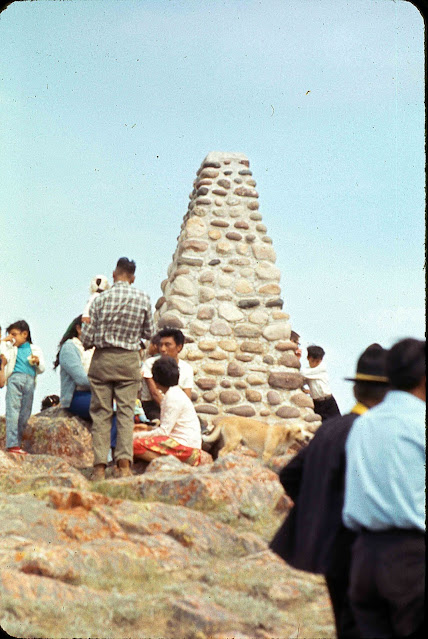 |
| The two figures on Monument Hill seem to be waving at the artist. |
 |
| The airplane is a pretty accurate depiction of a Barkley-Grow T8P-1. Only eleven of these were made, with seven of them coming to Canada as they made good bush planes. I've researched all seven of them, and am pretty sure he painted CF-BTX as it was being used by CPA in the north at that time. It crashed beyond repair in 1945. |
 |
| My sister Tania receiving her Grade 9 graduation certificate from Sister Brady in 1966. Father Mercredi's painting is on the wall behind Tania. |
Sister Archange Jeanne Brady used the mural for the dust jacket on her excellent book A History of Fort Chipewyan. She gave me a copy in 1983, just five months before she died. She had very strong relationships with young people in Fort Chipewyan, which is evident in her book - every photograph has students' names lovingly recorded. She started teaching at Holy Angels school in 1950, and was principal for Bishop Piche School from its opening in 1961 until her retirement in 1976. At that time she was made Honorary Chief by the Cree and Chipewyan Band Councils, and given the Cree name Anah ka sakihat awassissa, The one who loves children. Her book is still for sale at the Fort Chipewyan Bicentennial Museum.
So who was Father Mercredi? I was surprised to find very little recognition for this man. He was born in 1904 in Fort Chipewyan to Vital and Sara (McDonald) Mercredi, a mix of French, Cree, Irish and Scot. From the age of seven until 17 he lived in the Holy Angels Residential School. He trapped with his father for a few years before returning to school, then in 1928 moved to Manitoba as a noviciate for the Oblates of Mary Immaculate. He spent time in France to "become cultured" (his words), and returned to Fort Chipewyan to be ordained as a priest in 1934. He then worked in several Cree communities in northern Saskatchewan and Alberta, mostly serving in settlements along the railway between Lac La Biche and Fort McMurray until he retired in 1970. His paintings of the stations of the cross are in the mission churches of St. Gabriel in Janvier and St. Vincent in Conklin. A high school in Fort McMurray is named in his memory.
 |
| Father Patrice Mercredi with the Mazur brothers in Fort McMurray, about 1946. |
The NWT Archives has Ray Price's notes from time he spent with Father Mercredi in 1977. In his interview Father Mercredi was very forthcoming regarding frustrations with his career, in particular having to struggle against racism all his life:
"... discriminated against by fellow priest, discriminated against by the Brothers in the service of the priesthood, discriminated against in college, and in seminary. And it was explicitly at one time that he was sent to France for 4 years in order to 'Frenchify' him, to make him a cultured man and to turn him into a Frenchman. They haven't been able to succeed and the older he gets the more he goes back to his roots, and he feels it is in Fort Chipewyan and in the North American Indian culture, a culture that was dependent directly upon the land...".


































